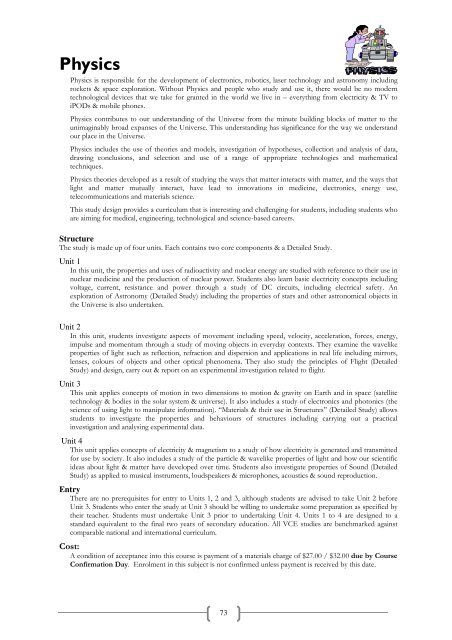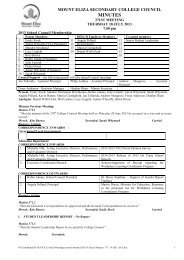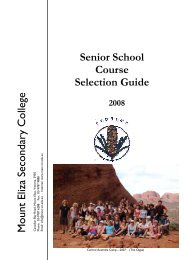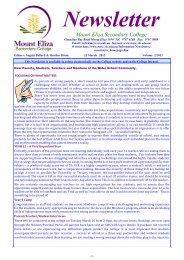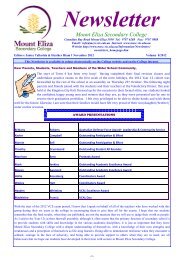9-12 Course Selection Guide - Mount Eliza Secondary College
9-12 Course Selection Guide - Mount Eliza Secondary College
9-12 Course Selection Guide - Mount Eliza Secondary College
You also want an ePaper? Increase the reach of your titles
YUMPU automatically turns print PDFs into web optimized ePapers that Google loves.
PhysicsPhysics is responsible for the development of electronics, robotics, laser technology and astronomy includingrockets & space exploration. Without Physics and people who study and use it, there would be no moderntechnological devices that we take for granted in the world we live in – everything from electricity & TV toiPODs & mobile phones.Physics contributes to our understanding of the Universe from the minute building blocks of matter to theunimaginably broad expanses of the Universe. This understanding has significance for the way we understandour place in the Universe.Physics includes the use of theories and models, investigation of hypotheses, collection and analysis of data,drawing conclusions, and selection and use of a range of appropriate technologies and mathematicaltechniques.Physics theories developed as a result of studying the ways that matter interacts with matter, and the ways thatlight and matter mutually interact, have lead to innovations in medicine, electronics, energy use,telecommunications and materials science.This study design provides a curriculum that is interesting and challenging for students, including students whoare aiming for medical, engineering, technological and science-based careers.StructureThe study is made up of four units. Each contains two core components & a Detailed Study.Unit 1In this unit, the properties and uses of radioactivity and nuclear energy are studied with reference to their use innuclear medicine and the production of nuclear power. Students also learn basic electricity concepts includingvoltage, current, resistance and power through a study of DC circuits, including electrical safety. Anexploration of Astronomy (Detailed Study) including the properties of stars and other astronomical objects inthe Universe is also undertaken.Unit 2In this unit, students investigate aspects of movement including speed, velocity, acceleration, forces, energy,impulse and momentum through a study of moving objects in everyday contexts. They examine the wavelikeproperties of light such as reflection, refraction and dispersion and applications in real life including mirrors,lenses, colours of objects and other optical phenomena. They also study the principles of Flight (DetailedStudy) and design, carry out & report on an experimental investigation related to flight.Unit 3This unit applies concepts of motion in two dimensions to motion & gravity on Earth and in space (satellitetechnology & bodies in the solar system & universe). It also includes a study of electronics and photonics (thescience of using light to manipulate information). “Materials & their use in Structures” (Detailed Study) allowsstudents to investigate the properties and behaviours of structures including carrying out a practicalinvestigation and analysing experimental data.Unit 4This unit applies concepts of electricity & magnetism to a study of how electricity is generated and transmittedfor use by society. It also includes a study of the particle & wavelike properties of light and how our scientificideas about light & matter have developed over time. Students also investigate properties of Sound (DetailedStudy) as applied to musical instruments, loudspeakers & microphones, acoustics & sound reproduction.EntryThere are no prerequisites for entry to Units 1, 2 and 3, although students are advised to take Unit 2 beforeUnit 3. Students who enter the study at Unit 3 should be willing to undertake some preparation as specified bytheir teacher. Students must undertake Unit 3 prior to undertaking Unit 4. Units 1 to 4 are designed to astandard equivalent to the final two years of secondary education. All VCE studies are benchmarked againstcomparable national and international curriculum.Cost:A condition of acceptance into this course is payment of a materials charge of $27.00 / $32.00 due by <strong>Course</strong>Confirmation Day. Enrolment in this subject is not confirmed unless payment is received by this date.73


